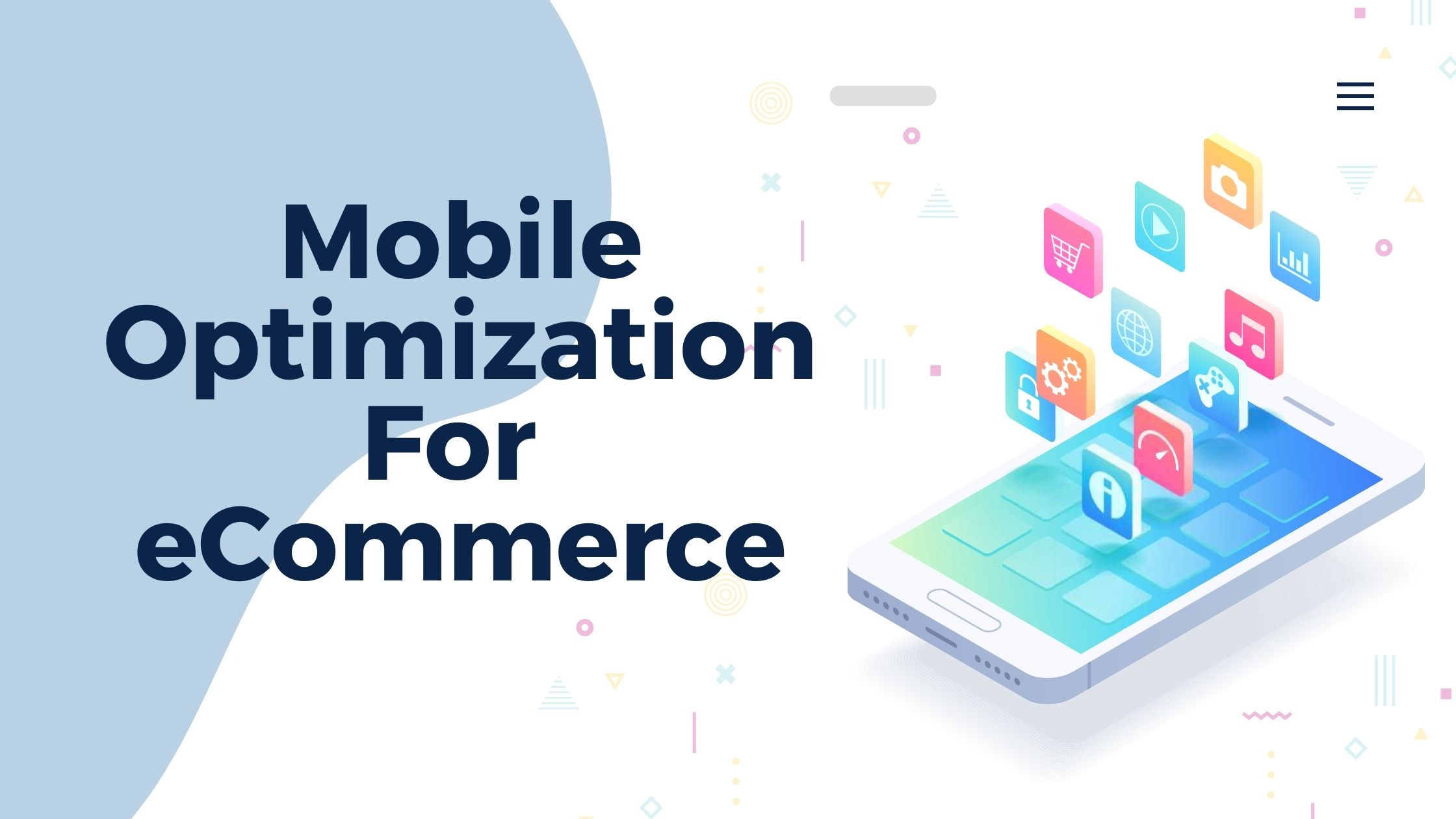Importance of Mobile Optimization for Ecommerce Store
Mobile optimization for ecommerce stores is super important these days. A lot of us shop using our phones, so if a business doesn’t make their website easy to use on mobile, they might lose out on a bunch of customers. Making websites that work well and look good on phones can really help businesses stand out in a busy market.
Mobile optimization is crucial for ecommerce stores, as it significantly impacts user experience and sales. Here are some key information on mobile optimization for ecommerce:
- 54.4% of global website traffic was generated by mobile devices at the end of 2021.
- Internet users spent half of their online time on mobile devices in 2021.
55.4% of internet users use mobile phones to buy online. - 50% of smartphone users prefer using a mobile site for browsing or shopping because they don’t want to download an app.
- 73.1% of web designers believe that non-responsive design is a top reason why visitors leave a website.
- 59% of shoppers say that being able to shop on mobile is important when deciding where to buy.
- 64% of SEO marketers consider mobile optimization an effective investment.
- Mobile website shopping increased by 48% during the COVID-19 pandemic.
- Reducing mobile site speed by 0.1 seconds can result in an 8% increase in conversion
What’s the impact of mobile commerce on Ecommerce success?
Mobile commerce has really changed the game for ecommerce. It’s like having a store in your pocket, which means businesses can reach more people than ever before.
Customers love the convenience. They can shop from anywhere, anytime, just using their phones. This not only bumps up sales but also helps businesses run smoother and more cheaply.
Plus, mobile commerce puts a big spotlight on making customers happy. Happy customers keep coming back, and that’s key for any business wanting to stick around in the online world.
You Can Reach More Audience
Mobile commerce really opens up the doors for ecommerce businesses, allowing them to reach millions of people around the world.
Lots of folks these days use their smartphones to surf the web, especially in places where not many have desktop computers. Getting your business ready for mobile users is a smart move. It means you can connect with people in new areas where more people are likely to be on their phones than on a computer.
This isn’t just about reaching more people. It’s also about connecting with all sorts of different folks. We’re talking different ages, backgrounds, and income levels who all enjoy using their phones.
Mobile devices are everywhere, and they let businesses catch customers’ attention anytime, anywhere. This is super handy when someone makes a spontaneous purchase or when you want to push a timely deal.
Provides Hassle-free Shopping Experience
Mobile optimization really changes the game when it comes to shopping online. It’s all about making things easy and fast for everyone.
With a design that responds to whatever device you’re using, websites become a breeze to navigate. This means you can find what you need on your phone just as easily as on your computer.
When a site adjusts to fit your phone’s screen, it loads faster and looks better. Images size up just right, so everything loads quick and keeps your attention.
Plus, features like tapping once to buy something or having your info fill in automatically make buying stuff super simple. Less hassle means you’re more likely to finish your purchase, and not just leave items sitting in your cart.
All these tweaks aren’t just for kicks; they make shopping smoother. This keeps customers happy and coming back, which is a big win for any online store.
Enhances Retail Sales
As mobile commerce grows, so does the success of ecommerce platforms.
More and more people prefer shopping on their mobile devices, and the numbers show it. Mobile sales are taking up a bigger slice of the ecommerce pie each day.
Stores that make their websites easy to use on phones tend to sell more and keep their customers coming back. Features like easy click-to-buy buttons and suggestions tailored just for you make shopping on your phone a breeze.
So, businesses that focus on making their sites mobile-friendly are really setting themselves up to win big in the ever-changing world of retail.
It’s pretty clear, right? If you’re in the retail game, getting your mobile game on point is key.
Not only do you boost your sales, but you also build a loyal customer base that loves how easy you make it for them to shop. And in today’s fast-paced world, that’s a big plus.
Lowers Costs and boosts productivity
Making your website work better on phones can really help your online store. When your site is easy to use on mobile, it not only helps boost your sales, but it also cuts down on your costs and makes your whole operation run smoother.
When your mobile site is easy to navigate, customers can do things like find products and check out all by themselves. This means they don’t need to call or message your support team as much, which can save you some money on labor costs and other stuff you’d normally need to help customers out.
Not only does this make things easier for your customers, but it also makes handling your inventory and orders much faster. This speeds up how quickly you can sell stuff. When things move faster, your business can handle more sales without messing up, which is pretty great for staying ahead of the competition.
When your mobile site works well, everything in your business just works better and faster. You save money, make your customers happier, and even get a leg up on other businesses. It’s a win all around!
Prioritizes customer experience
When we talk about boosting the customer experience, making your online store mobile-friendly is key. It’s all about meeting the needs of today’s shoppers who want fast and easy access.
By optimizing for mobile, your website won’t just load faster, but it’ll also be a breeze to use on smaller screens. This kind of smooth experience keeps customers happy and less likely to ditch their shopping carts.
Now, let’s add some cool features like one-tap payment options, customized suggestions, and quick customer service. These aren’t just nice to have; they make shopping feel more personal and efficient.
Customers start to see your brand in a better light, and that’s good news because happy customers tend to come back.
Easy Shopping
Mobile commerce really boosts ecommerce by making shopping smooth and easy. It’s super handy because you can shop from anywhere, anytime, right from your smartphone. You can look up stuff, check out different products, and buy them without a hassle. (1)
Because it’s so convenient, people end up buying more often and on the spur of the moment, which means more sales and customers sticking around.
Also, making sure the shopping experience doesn’t frustrate anyone is key. That’s where mobile optimization comes in. With features like responsive design and easy-to-navigate pages, everyone has a good time shopping.
And guess what? Happy shoppers are more likely to come back.
Adding cool features like one-click ordering and suggestions tailored just for you can really make a difference. Ecommerce businesses are all about keeping up with what mobile shoppers want, and these tweaks can really help their earnings.
How to Optimize an Ecommerce Store for Mobile?
When you’re setting up your ecommerce store for mobile users, you’ve got to keep a few key things in mind.
First off, make sure your website design is responsive. This means it’ll look good and work well no matter what device someone is using, from smartphones to tablets.
Next, speed is super important. Nobody likes to wait, especially when they’re ready to buy. So, work on making your website load faster.
You can also make finding products easier by cleaning up your site’s navigation. Keep it simple and straightforward.
Now, let’s talk about checking out. You want to make this as easy as possible. Fewer steps are better.
And don’t forget about keeping everything secure. Make sure your customers feel safe when they’re shopping with you.
So there you have it! With these tips, you’ll be on your way to creating a great mobile shopping experience.
Just remember, keep it simple, make it fast, and secure those purchases.
Responsive Web Design
Implementing responsive web design is super important if you’re running an ecommerce store, especially for folks browsing on mobile devices. It makes sure your website looks good and works well no matter the screen size.
Let’s dive into some must-know elements:
- Fluid Grids: Start using fluid grid layouts. These rely on relative units like percentages instead of fixed ones like pixels. This helps everything on your site adjust smoothly as the screen size changes.
- Flexible Images: You’ll want to make sure your images can scale up or down without messing up your layout. It keeps everything looking sharp and in place.
- Media Queries: These are like magic spells for your CSS, allowing you to switch up styles based on things like screen width, resolution, and whether the device is flipped sideways.
- Touchscreen Readiness: Since a lot of users will tap and swipe on their screens, make your buttons big enough to hit easily and menus that respond well to touch.
Fast Loading Times
When you’re setting up an ecommerce store, fast loading times are super important. Let’s face it, nobody likes to wait, especially online shoppers. If your pages load slowly, you might see more people leaving your site, and that’s a big no-no.
So, how do you speed things up?
First off, take a look at your images. They can really slow your page down if they’re too big. Try compressing them to reduce their file size without messing up their quality. This makes your pages load faster. Also, try to keep your website’s code nice and clean. Cut down on heavy scripts that can drag your loading speed down.
Another cool trick is using lazy loading. This means images and videos load only when they actually need to, like when someone scrolls to them. Pretty neat, right?
Plus, don’t forget about caching. It helps your regular visitors load your pages quicker, which keeps them happy and more likely to stick around.
Mobile-Friendly Navigation
Making sure your online store is easy to use on mobile devices is super important. It helps shoppers have a smooth experience even on small screens. Better navigation means more people stick around and buy stuff.
Simple Menus: Keep your menus short and sweet. Organize them in a way that makes sense so people don’t get lost.
Easy-to-Tap Buttons: Make sure buttons are big enough to tap without a hassle. Nobody wants to fight with tiny buttons.
Search Bar Up Top: Put a big search bar right at the top. This way, finding products is a snap.
Breadcrumb Links: Use breadcrumb links. They let shoppers go back to where they were without hitting the back button a million times.
Just a little tweak here and there, and you’ll see happy customers sticking around longer. It’s all about making shopping as easy as pie.
Simplified Checkout Process
A simplified checkout process is key to making mobile shopping a breeze and keeping cart abandonment low.
When you cut down the steps needed to buy something, fewer shoppers drop off. You can do this by setting up a one-page checkout. (1)
One-page checkout means everyone types in their info on a single page without jumping to others.
Plus, it helps to have various payment options that are easy to use on mobiles.
This way, customers can pick what works best for them and breeze through payment.
Also, if you auto-fill customer data and use clear, big form fields, it makes everything smoother.
These tweaks make checking out super easy, turning those just browsing into actual buyers.
Enhanced Mobile Security
Making your checkout process easier is awesome for your customers, but don’t forget about beefing up your mobile security. That’s just as important for keeping everyone safe.
In today’s world, where everyone’s glued to their phones, we can’t think of security as something we’ll get to later. It’s vital for keeping the trust of your shoppers and making sure they have a safe place to hit that ‘buy’ button.
Use Strong Encryption: Always encrypt data when you send it out. This stops the bad guys from sneaking a peek at your info.
Do Security Check-ups: Keep an eye on your security with regular check-ups. This helps you catch the sneaky bugs before they cause trouble.
Add Extra Steps to Log In: Don’t just settle for passwords. Use something extra for logging in, like a code from your phone or a fingerprint.
Keep Everything Updated: Make sure your apps and systems are always up to date. New updates mean better protection against the latest tricks from hackers.
Security isn’t just a nice-to-have. It’s a must-have. Keeping things safe keeps your customers coming back.
Mobile Payment Integration
Making your ecommerce store better with mobile payment options is pretty important. You want to make buying stuff as easy as possible for your customers, right?
So, adding different ways to pay, like credit cards, digital wallets, or even mobile banking apps, helps a lot. It means more people can buy from you because they can use their favorite way to pay.
Now, you’ve got to make sure these payment methods work well on mobile devices. Nobody likes a clunky checkout process.
You want it to be fast and easy. Keep the steps to buy something as few as possible. Also, features like one-tap purchasing and auto-fill info are super handy. They can help stop people from ditching their shopping carts.
How can I improve my Ecommerce store’s mobile experience?
Improving your ecommerce store’s mobile experience is super important these days. You want to make sure your website works well on all devices. This is called mobile-first design. It’s all about making sure your site is easy to use whether someone is on a phone, tablet, or computer.
You can also spice things up by offering personalized product recommendations. Who doesn’t like a personal touch, right? Plus, think about creating an omnichannel experience. This means your customers can have a smooth shopping experience whether they’re online from a mobile device, a laptop, or even in a physical store.
All these steps can really help boost user engagement and satisfaction. Making shopping easy and fun keeps customers coming back for more.
Understand Your Target Audience
To boost your ecommerce store’s mobile experience, getting to know your target audience’s likes and habits is key. When you understand what your customers need and expect, you not only make them happier but also increase engagement and sales.
- Conduct Surveys and Polls: It’s smart to ask your customers directly what they need and how they use their mobile devices for shopping.
- Analyze Demographic Data: Use analytics tools to look into factors like age and location, which can tell you a lot about how people shop.
- Monitor Social Media Trends: Keep an eye on what’s trending and what your audience is talking about on social platforms they like.
- Study Customer Reviews: Listening to what customers say about using your mobile site and their shopping experiences can give you many insights.
Optimize Your Site for Mobile First
If you’re running an ecommerce store, it’s super important to think ‘mobile-first.’ Because everyone’s on their phones these days!
Start with a responsive design. This just means your site will look good on any device, big or small. It’s all about flexible layouts and images that adjust to different screen sizes.
Speed is key too. Nobody likes a slow website. You can speed things up by keeping your images small and using something called browser caching. This helps your site to load faster, keeping those potential customers from bouncing.
Let’s talk navigation. Keep it simple. You want folks to find what they need without a lot of zooming and scrolling. Make it easy to get around your site.
And don’t forget the checkout process! Make it smooth and quick. Include different payment options that work well on mobiles. This can really help cut down on folks leaving stuff in their carts.
Personalized Product Recommendations
Personalized product recommendations can really step up your game on a mobile ecommerce platform.
By using user data and predictive analytics, these tailored suggestions make it way easier for shoppers to spot products they’ll love.
Utilize Customer Data: Dive into browsing history and purchase patterns to show relevant products.
Implement Machine Learning: Let algorithms work their magic to predict and suggest items based on what users do.
Optimize for Mobile Display: Make sure those recommendations look good and are easy to browse on small screens.
Continuous Improvement: Keep tweaking those algorithms. Use customer feedback and fresh data to sharpen those product suggestions and keep users coming back for more.
Just imagine, with a few tweaks here and there, your platform becomes a mind reader—almost knowing what your shopper wants next!
Create an Omnichannel Experience
Creating an omnichannel experience really steps up your game when it comes to mobile ecommerce. It’s all about making sure everything works smoothly together, whether you’re online, on your app, or in a physical store. You get a consistent brand vibe everywhere.
By keeping data the same across the board and updating it in real time, customers can hop from one device to another without any hassle. They won’t lose track of their shopping cart or their preferences, which really ramps up both engagement and satisfaction.
So, let’s say you’re shopping on your phone and you add something to your cart. Later, whether you’re on your laptop or swinging by an in-store kiosk, you can pick up right where you left off.
Super convenient, right? By using stuff like cloud services and APIs, everything stays in sync. Whether it’s checking if an item is in stock, the price, or if there’s a sale, the info is right at your fingertips.
This kind of smooth experience doesn’t just make things easier; it also builds trust and keeps customers coming back for more.
What are the types of mobile commerce?
Mobile commerce, or m-commerce, has a few different types that make shopping and managing finances a breeze.
- Mobile Shopping: Ever found yourself browsing for goodies on your phone? That’s mobile shopping. You can visit online stores or use apps to buy whatever you need, right from your smartphone.
- Mobile Banking: Need to check your bank balance or pay a bill quick? Mobile banking lets you handle all that money stuff straight from your phone. It’s like having a bank in your pocket!
- App-Based Services: Think about ordering a ride or getting food delivered without making a call. Apps for services like these make our lives a lot easier and are all part of mobile commerce.
- Mobile Payments: Ever tapped your phone on a checkout reader to pay? That’s using mobile payments. Technologies like Apple Pay and Google Wallet let you zip through paying without digging for your wallet.
Is a mobile app necessary for my Ecommerce store?
So, do you need a mobile app for your ecommerce store? Well, it really comes down to who’s buying from you and what you want to achieve with your business.
If you find out that many of your customers love shopping on their smartphones, then having a mobile app might make their experience much better and even boost your sales. Plus, apps have some cool extras like push notifications and loyalty programs that can really help keep your customers coming back for more.
But, remember, making and keeping an app up and running isn’t free. You’ve got to look at what it will cost versus what it will bring in.
Think about how big your business is, what your customers are like, and what your competitors are doing. You want to make sure it makes sense for your business in the long run and really helps out your customers.
In the end, it’s all about matching up with your big plans for the future and making sure your customers are happy. So, weigh your options carefully and see if an app fits into your vision!
What features should a mobile e-commerce app have?
If you’re diving into building a mobile e-commerce app, there are a few must-have features that can really make or break your user’s experience.
- User-Friendly Interface: Think about making everything super simple to find and use. A clean layout helps users zip through your app without getting frustrated.
- Secure Payment Gateways: Nobody wants to worry about security when shopping online. Make sure you offer several well-trusted payment options so your users can choose their preferred way to pay without stress.
- Push Notifications: Keep your users in the loop with alerts on cool new products, sweet deals, and important updates. It’s like giving them a friendly nudge to check out what’s new.
- Personalized Experience is key. Track what your users look at and buy, then suggest products that fit their style. It’s like being that friend who knows exactly what they’ll love.
There you have it! Stick to these core features and your app will not only meet the basics but also provide a smooth and engaging shopping experience.
What are common mobile shopping challenges?
Shopping on your phone should be easy, right? But sometimes, it’s anything but.
For starters, mobile websites can be really slow to load. If a site takes forever to show up, chances are you might just give up and not buy anything.
Then there’s the issue of navigating these sites. Because phone screens are smaller, everything needs to be simpler and easier to tap. If it’s too complicated, finding what you want can be a real headache.
Ever found the perfect item but couldn’t buy it because the site didn’t take your preferred payment method? Yeah, that happens a lot on mobile sites. It’s pretty annoying.
And let’s not forget security worries. With all the scary stories out there, it’s normal to feel a bit uneasy about typing in your card details.
How does mobile SEO differ from desktop SEO for e-commerce?
Getting a handle on mobile shopping starts by figuring out how mobile SEO stands apart from desktop SEO in e-commerce. There are a few key differences that really change the game when it comes to how users experience your site and how visible you are in search results.
First off, we’ve got Page Speed Optimization. Mobile SEO needs your pages to load super fast. Why? Because mobile devices often have slower internet and aren’t as powerful as desktops.
Next up is User Experience (UX). When you’re designing for mobile, you have to think about those smaller screens. Everything needs to be easy to navigate and pretty straightforward, keeping things simple to improve how users interact with your site.
Then there’s Local SEO Emphasis. When people search on their phones, they’re often looking for something nearby. So, for mobile, it’s super important to dial in your local SEO. It makes a big difference.
Lastly, Voice Search Optimization. With more folks using their phones to do voice searches, your keyword strategy has to adapt. You need to think about natural language and how people actually talk when they ask questions out loud.
Wrapping Up
Making your ecommerce store work well on mobile devices is super important. It makes shopping way easier and more fun for everyone. When your site is easy to use on a phone, more people stick around, browse, and actually buy stuff. Plus, everyone expects a smooth experience on their mobile these days.
To stay in the game, online stores really need to focus on making their sites mobile-friendly. This means things like making sure your website looks good and works fast on smartphones and considering building an app just for mobile users.
You also want to make sure that your store shows up high in search results when people use Google on their phones.
And hey, don’t wait around to see if mobile shopping will become a big deal— it already is! Getting ahead of the game and solving mobile shopping issues early on can really help keep your customers happy and coming back as things keep changing online.
A Complete Guide on Ecommerce Store Product Pages
A Complete Guide on Ecommerce Store Product Pages In ecommerce, the product page is where a...
7 Benefits of Using Glitching.ai for Your Dropshipping Business
7 Benefits Of Using Glitching.ai For Your Dropshipping BusinessHarnessing artificial intelligence...
Tips for Best Ecommerce Store Designs in 2024
Tips for Best Ecommerce Store Designs in 2024 As we progress through 2024, ecommerce store...






